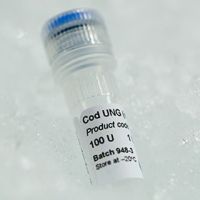PCR Carry-over Prevention
Carry-over contaminants from previous PCRs are considered to be one of the major sources of false positive results
There are two common strategies to prevent carry-over contaminants when amplifying DNA and RNA. One is to have a separate lab for set-up and amplification, minimize the number of pipetting steps, and prevent opening of the tube after amplification. However, this is not always possible due to practical reasons. Moreover, it offers no guarantee for avoiding carry-over contamination.
The other most common strategy to prevent carry-over contamination is to partially or completely replace dTTP with dUTP during PCR amplification, thereby producing DNA containing uracil. Prior to initiating PCR, the PCR mixture is treated with Uracil-DNA Glycosylase (UNG). During the initial denaturation step temperature is elevated to 95°C, resulting in cleavage of apyrimidinic sites and fragmentation of carry-over DNA. As the template contains thymidine, it will not be affected by the UNG treatment. It is a prerequisite that all PCRs are carried out with dUTP substituting dTTP.
The benefit of using our Cod UNG is that it is irreversibly inactivated at 55˚C. Cod UNG is the only UNG compatible with one-step RT-qPCR!
- Cod Uracil-DNA Glycosylase
The only true heat-labile Uracil-DNA Glycosylase


